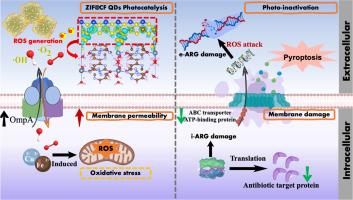Blocking antibiotic resistance contamination dissemination to neutralized the impacts of bacterial oxidative stress via efficient photocatalysis
IF 12.4
1区 环境科学与生态学
Q1 ENGINEERING, ENVIRONMENTAL
引用次数: 0
Abstract
Transmission of antibiotic resistance genes (ARGs) in wastewater, which seriously threaten the ecological safety and human health, has attracted increasing attention recently throughout the world. However, the correlations between bacterial interaction and environmental stress in photo-inactivation are rarely studied. In this study, the efficient photo-treatment of ZIF@CF QDs-Fe for ARGs removal were explored, attributed to the superiority electric transfer rate and stable redox cycles of ZIF@CF QDs-Fe heterojunction. The experimental results revealed that the leaked e-ARGs and mobile genetic elements (MGEs) were immediately captured and attacked by the extracellular ROS (·OH, ·O2–), which could block the antibiotic-resistance dissemination. Meanwhile, ZIF@CF QDs-Fe photo-treatment further neutralized the negative effect of ROS induced oxidative stress, benefiting for the controlling of ARGs conjugative transfer. Combined with bacterial interactions, both the bacterial density and the abundance of dominant ARGs host was synergically reduced when the photo-treatment progressed, thus alleviating the ARGs natural dissemination risk. Meanwhile, the downregulation of transporter proteins and antibiotic target proteins elucidated that the ARGs transcription and bacterial reproduction were significantly suppressed under photo-inactivation. Interestingly, partial of the antibiotic bacterial sensitivity would be recovered through the regulations of bacterial functional expressions and further alleviated the potential ecological risk. Overall, these findings shed light on the inactivation mechanism of the nanomaterial mediated photo-treatment in blocking the resistance transfer pathways, giving valuable guidance for mitigating the antibiotic resistance dissemination in wastewater treatments.

阻断抗生素耐药性污染传播,通过有效的光催化来中和细菌氧化应激的影响
抗生素耐药基因(ARGs)在废水中的传播严重威胁着生态安全和人类健康,近年来越来越受到世界各国的关注。然而,在光灭活过程中,细菌相互作用与环境胁迫之间的相关性研究很少。在本研究中,由于ZIF@CF QDs-Fe异质结具有优越的电传递速率和稳定的氧化还原循环,我们探索了ZIF@CF QDs-Fe对ARGs的高效光处理。实验结果表明,泄露的e-ARGs和移动遗传元件(MGEs)立即被细胞外ROS(·OH,·O2 -)捕获和攻击,从而阻断抗生素耐药性的传播。同时,ZIF@CF QDs-Fe光处理进一步中和了ROS诱导的氧化应激的负面影响,有利于控制ARGs的共轭转移。结合细菌相互作用,随着光处理的进行,细菌密度和优势宿主丰度都协同降低,从而减轻了ARGs的自然传播风险。同时,转运蛋白和抗生素靶蛋白的下调表明,在光失活条件下,ARGs的转录和细菌繁殖受到显著抑制。有趣的是,通过调节细菌的功能表达,部分抗生素细菌的敏感性将得到恢复,并进一步减轻潜在的生态风险。总的来说,这些发现揭示了纳米材料介导的光处理在阻断耐药性转移途径中的失活机制,为减轻废水处理中抗生素耐药性的传播提供了有价值的指导。
本文章由计算机程序翻译,如有差异,请以英文原文为准。
求助全文
约1分钟内获得全文
求助全文
来源期刊

Water Research
环境科学-工程:环境
CiteScore
20.80
自引率
9.40%
发文量
1307
审稿时长
38 days
期刊介绍:
Water Research, along with its open access companion journal Water Research X, serves as a platform for publishing original research papers covering various aspects of the science and technology related to the anthropogenic water cycle, water quality, and its management worldwide. The audience targeted by the journal comprises biologists, chemical engineers, chemists, civil engineers, environmental engineers, limnologists, and microbiologists. The scope of the journal include:
•Treatment processes for water and wastewaters (municipal, agricultural, industrial, and on-site treatment), including resource recovery and residuals management;
•Urban hydrology including sewer systems, stormwater management, and green infrastructure;
•Drinking water treatment and distribution;
•Potable and non-potable water reuse;
•Sanitation, public health, and risk assessment;
•Anaerobic digestion, solid and hazardous waste management, including source characterization and the effects and control of leachates and gaseous emissions;
•Contaminants (chemical, microbial, anthropogenic particles such as nanoparticles or microplastics) and related water quality sensing, monitoring, fate, and assessment;
•Anthropogenic impacts on inland, tidal, coastal and urban waters, focusing on surface and ground waters, and point and non-point sources of pollution;
•Environmental restoration, linked to surface water, groundwater and groundwater remediation;
•Analysis of the interfaces between sediments and water, and between water and atmosphere, focusing specifically on anthropogenic impacts;
•Mathematical modelling, systems analysis, machine learning, and beneficial use of big data related to the anthropogenic water cycle;
•Socio-economic, policy, and regulations studies.
 求助内容:
求助内容: 应助结果提醒方式:
应助结果提醒方式:


